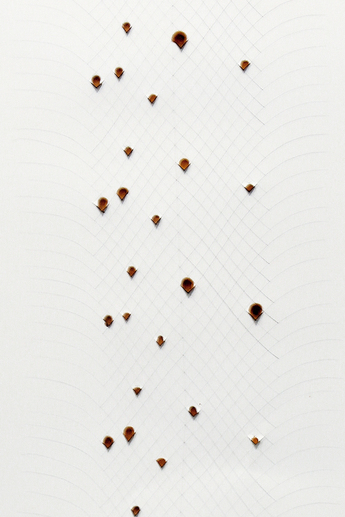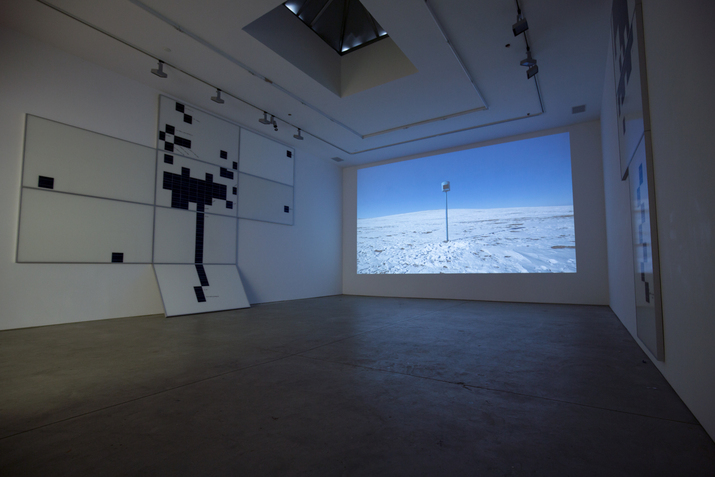-
From Current Issue
-
- Editor’s Letter Fire in the Heart
- Reviews I Gusti Ayu Kadek Murniasih
- Reviews 11th Seoul Mediacity Biennale: “One Escape at a Time”
- Dispatch Networked China
- One on One Monira Al Qadiri on Yukio Mishima
- Essays The rise of independent art spaces in pandemic-era Shanghai
- Features Tuan Andrew Nguyen
- Table of Contents
- Web Exclusives
- Archive
- Subscribe

R
E
V N
E
X
T
Installation view of TUGULDUR YONDONJAMTS‘s Echidna in the Permafrost #1 and Echidna in the Permafrost #3, both 2016, charcoal and dragon’s blood on paper, 114.3 × 237.5 cm and 114.3 × 226.1 cm. Courtesy the artist and Richard Taittinger Gallery, New York.
An oversized sewn skeletal alligator hung at the entrance of the gallery. Inside, on the opposite wall, large intricate charcoal drawings of a mountain range expanded above the works into a jagged terrain constructed with metallic silver foil, drawing attention to Tuguldur Yondonjamts’s native Mongolian landscape, its archeological discoveries, and mythical tales in his first solo exhibition in the United States, “Hibernating Tattoos Guarding the Sweat of the Sun.”
Inspired by his training in Buddhist thangka painting, the drawings of Tuguldur, otherwise known as Togo, embody the Buddhist idea of maya—or modes of shifting perspectives. The painstakingly drawn territory is created using a technique of shading that forms illusions of snow-covered ridges and rough rocky surfaces plunging into deep ravines and crevices. Appearing like a blueprint of hidden secrets and ancient treasures, his elaborate webs of dark and light lines of varying thickness spread out like shadows across large sheets of paper. On closer inspection, Togo’s drawings, Echidna in the Permafrost #4 (2016) and #5 (2017), reveal semblances of many images at once. Faces of odd-looking monsters, enormous slithering snakes, and immense, uninhabitable and seemingly dangerous frozen expanses emerge from careful observation. These works of veritable Rorschach inkblots, named after Greek mythological monsters Echidna and Ladon, become palimpsests of Togo’s representation of his own culture.
Togo’s abstractions emblematize the Mongolian struggle since gaining independence from Soviet control in 1990, retrieving repressed shamanistic practices and mythological history. In addition, fossils and mummies found embedded in the Mongolian permafrost by Russian paleontologists have rekindled links to the Scythia nomadic tribe that ruled central Asia around the 9th century BCE. More recently, the unlikely discovery by scientists of the remains of an alligator in the frozen Altai Mountains bordering Mongolia have greatly impacted Togo’s imagination.
The connection to Togo’s heritage and cultural legends is further underscored by his use of red dragon’s blood—sap taken from the Socotra dragon tree, which is found on islands in the Arabian Sea that are part of Yemen—to form surreal maps of his esoteric and acutely personal relationship with his homeland and ancestry. Faintly visible geometric networks of crimson sinuous lines, intermittently sprinkled with the Greek alphabet, form a platform at the base of the “Echidna” series, while snakes’ scales rendered in a grid-like pattern from Ladon Meets Hercules (2016) appear on scrolls.
Yet Togo’s deepest connection to his family and prior generations can be seen in his 25-minute video An Artificial Nest Captures A King (2016), which was commissioned by the SculptureCenter in New York. Filmed from an aerial perspective, opening shots of an immobile alligator, which was crafted from fabric and cleverly stitched to double as a sleeping bag (it was also hung at the entrance of the gallery), on frozen glaciers in the mountains transform into Togo’s performative work when we see the artist unzip its mouth, slide into its cavernous body, and help it move. Imagined as a journey of discovery, sounds from a 1980’s Russian utility vehicle that was used by the scientists during their research, as well as music from shamanistic rituals, trace the conjunction between real and imagined worlds. Toward the end, images of solar panels, arranged to resemble chess boards—a reference to Togo’s regular chess games with his father since childhood—not only brings the artist closer to his father, the landscape and scientific research, but additionally connects the panels associated with solar waves from the sun to the Mongolian belief in animism.
This somewhat literal and less successful conceptualization of Togo’s interests led an onlooker at the exhibition’s opening night to ask, “So what exactly does this mean?” But the drawings still stand out for their workmanship and aesthetic quality. Akin to American artist Maya Lin’s mesmerizing creation of imaginary mapping fields that frequently reference waterways and landscapes, Togo’s black charcoal swirls dance like magnetic ripples with their own self-governing system. These drawings, which possess the calming quality of images of planetary constellations, might be seen as tattoos, perhaps even as insignias for his culture that can be passed down to many generations.
Tuguldur Yondonjamts’s “Hibernating Tattoos Guarding the Sweat of the Sun” is on view at Richard Taittinger Gallery, New York, until August 27, 2017.
To read more of ArtAsiaPacific’s articles, visit our Digital Library.







